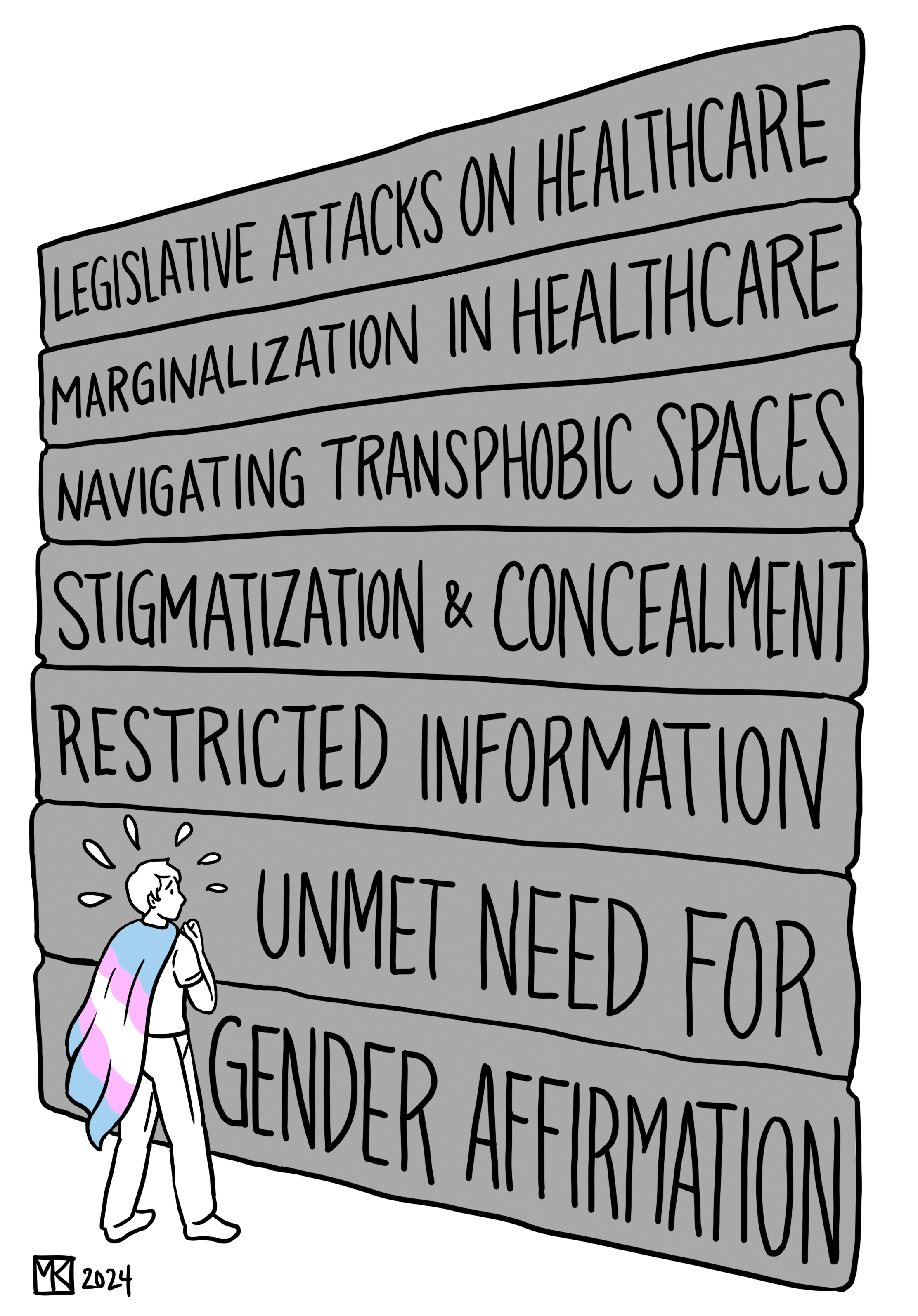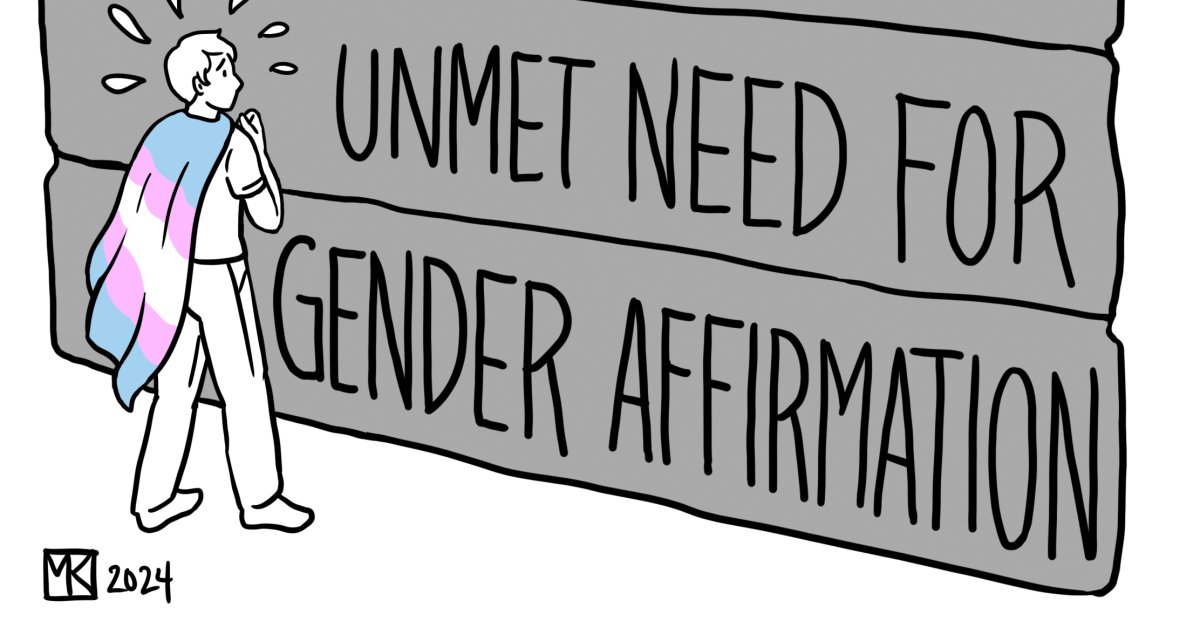
Chest binding, or wearing anything to flatten the chest in order to appear masculine or androgynous, is one of many ways that transmasculine and nonbinary people can affirm their gender identity and harmonize their physical presentation with their sense of self. Some people bind in order to “pass” as male at times when being visibly transgender could be dangerous. Others bind for the mental health benefits, documented across multiple studies, of being able to move through the world feeling at home in an authentic identity. But despite these life-changing benefits, anti-trans activists focus on the risks of binding, such as shortness of breath, skin abrasions, or shoulder pain, and seek to restrict the practice.
[time-brightcove not-tgx=”true”]Binding scares anti-trans activists because of its accessibility. Unlike hormones, binding requires no prescription; unlike state-ID changes, it requires no paperwork. Binding is often one of the first ways that trans and nonbinary youth who are assigned female at birth can flexibly, reversibly—sometimes quietly under their clothes and unbeknownst to anyone else—“try on” a new gender identity to see how it feels. This accessibility makes binding terrifying to those who want to eradicate trans people from public life. Their usual tricks are powerless to stop binding: there is no teacher they can gag, no librarian they can defund, no doctor they can criminalize to stop people from binding. Unless anti-trans zealots are willing to ban sports bras, bandages, tape, shapewear, or even swimsuits and tight shirts, there is no way to render binding completely inaccessible.
It is no surprise then that anti-trans activists hyperfocus on the health risks of binding, often misrepresenting studies on binding to inflate the physical risks of binding and ignoring the sometimes life-saving mental health benefits. We know because one of us (Sarah Peitzmeier) conducted most of those studies. Tired of seeing statistics from these research studies ripped out of context and weaponized against the very communities who participated in and supported the research, we began to discuss turning the findings from these studies into a book. Breathe: Journeys To Healthy Binding, is a resource for those who have questions and concerns about binding, and for those who already bind and want to do so in ways that maximize the mental health benefits and minimize the physical risk. We want to help people bind in ways that are affirming, yet gentle on the body.
Read More: Elliot Page: Embracing My Trans Identity Saved Me
Anti-trans activists who claim to be “protecting” people from the harms of binding by trying to restrict binding specifically and trans people more generally are in fact making binding more dangerous. In our research and lived experience, here are six ways we have seen transphobia make binding far more dangerous than it should be for trans and gender diverse people.
Legislative attacks on medically necessary healthcare
Binding is the only option left to mitigate chest dysphoria in states where best-practice medical care has been banned. Anti-trans bills blocking medical or surgical affirming care for trans youth have been passed in 24 states, with politicians inserting themselves between patients, families, and their doctors. Trans youth who go through puberty early without access to puberty blockers may have to manage severe chest dysphoria for a decade before they are even legally allowed to pursue top surgery, assuming they have the financial resources to access it. We know that receiving puberty blockers, compared to wanting puberty blockers but being unable to access them, is associated with 70% lower lifetime odds of suicidal ideation – so this is lifesaving care. It seems particularly cruel, then, for the same people who advocated for these laws denying healthcare to also attack binding. If anti-trans activists truly cared about the potential risks of binding for trans youth, they would not simultaneously advocate for bans on medically necessary care.
Marginalization in healthcare
Trans patients who do experience injuries or health issues from binding often don’t have access to knowledgeable and compassionate treatment. Even trans-affirming providers generally receive no training in how to counsel patients to reduce their risk around binding, as medical and nursing schools typically see trans-specific topics like binding as “specialty” topics. At worst, providers may be actively prejudiced against trans people. Laws against providing gender-affirming care in 24 states can be interpreted broadly and scare providers from offering any kind of care to trans adolescents or even adults. Binding-related medical issues are thus left to worsen without quality clinical care.
Binding can be necessary to navigate transphobic spaces
Being visibly trans can expose people to discrimination, and binding is sometimes the only way to safely move through a hostile world. It is still legal to discriminate against trans people in employment or housing in 30 states, and trans people are banned from using the restroom that matches their gender in 10 states. Some trans people may present as otherwise masculine but for the appearance of their unbound chest, which would “out” them as transgender. Until we live in a world where people can safely express a range of gender presentations without living in fear of assault or discrimination, binding is essentially the only option for many transmasculine people who need to “pass” for their own safety. These people may also have to keep binding for safety reasons regardless of any symptoms they may develop.
Concealing binding due to stigma increases the risks
The health risks from binding are increased by the need to conceal it. For instance, teens who are trying to conceal their binder from their parents often have trouble washing their binder regularly without their parents seeing it in the laundry. As a result, the dirt and sweat buildup on their unwashed binder predisposes them to skin complications. Without parental support, many teens cannot purchase a binder, which is typically ordered online with a credit card. Some of these teens resort to using ACE bandages, which are more readily available but far more dangerous because they are designed to compress inflammation. One 2020 study by researchers and clinicians at the Children’s Hospital of Los Angeles found that teens with parents who opposed binding were almost twice as likely to have used ACE bandages to bind their chests. Teens with supportive parents had access to safer options.
Restricted access to information on safer binding that does exist
Because discussing gender identity is banned or restricted in schools in 14 states, trans and nonbinary people often struggle to access information about trans-specific issues such as binding. We have a growing evidence base and clinical expertise around how to reduce risk associated with binding—including taking one day off from binding each week, avoiding use of ACE bandages, and stretching muscles and ligaments that may be constricted by binding—but in an era of book bans and gag rules, many trans people have no way to learn these important tips. Instead, they may assume that binding is inherently painful and this is just the price they have to pay, which is unequivocally not true. We now know there are so many ways to make binding safer.
Unmet need for gender affirmation
When there is a gap between how people fundamentally see themselves and how the world sees them, they are more likely to engage in risky (but identity-affirming) behaviors to help close that gap. When trans people are chronically misgendered at work or school and are banned from medically affirming their gender, binding may be one of the only tools they have to affirm their gender. They will be more likely to ignore signs that their body is struggling with the side effects of binding, as they have nothing else to affirm them. Combine this with lack of information about how to bind more safely and lack of healthcare to address problems that emerge, and people can end up with serious binding-related symptoms.
Forty percent of trans adults in the U.S. have attempted suicide at some point in their lives. Binding can help people imagine a future for themselves that feels worth living. As one of our research participants said, “Binding gave me the freedom to exist.”
Many people successfully bind with minimal physical side effects even in today’s world. If every trans person who wanted to bind could do so with a properly fitting binder, while living day to day without fear violence for being visibly trans, all while having access to knowledgeable and affirming medical care (including puberty blockers or top surgery as desired and appropriate), binding could become safer for everyone.
It’s on all of us to create that world. We call on everyone to fight back against anti-trans legislation, disrupt anti-trans hostility, and to support the trans youth and adults in our communities as they become their most authentic selves.
























